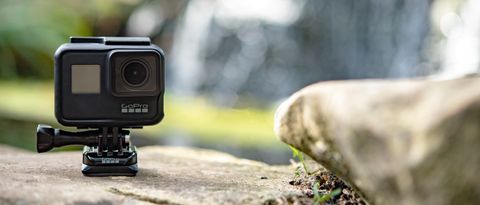Why you can trust TechRadar
GoPro Hero 7 Black review: video and photo quality
On top of its various fancy video tricks, the Hero 7 Black is capable of outputting 12MP images, both in raw or JPEG flavors. And while the GoPro Hero 7 Black may have a tiny 1/2.3in sensor, image quality itself is very good.
In good light, details are nice and crisp, and sharpness extends very well to the peripheries and corners of the frame. Close scrutiny shows images to have the same kind of character as those from smartphones than compact cameras – there’s clearly a fair bit of processing going on to eek out the best from the Hero 7 Black – but results are perfectly respectable for such a camera.

To be able to get such a wide angle of view on the GoPro Hero 7 Black, the lens is uncorrected for its distortion in its default Wide setting, so anything with linear details – particularly close-up subjects – will appear with the kind of distortion that many associate with GoPro cameras. Less good if you want to go out and shoot some architecture, but potentially very useful if you want to pretend you're in a lo-fi Busta Rhymes video.

Wide FOV

Linear FOV
You can, however, switch to the Linear mode to capture images with corrected distortion, though obviously at the slight expensive of field of view. Or, you can use the GoPro Hero 7 Black's Touch Zoom for a narrower field of view, although this acts like a digital zoom, maintaining output at 12MP, which degrades quality. An option to simply cut down resolution to compensate for however far you zoom would be welcome.
The SuperPhoto option on the Hero 7 Black, which captures images with an additional 1.5-2 seconds per photo, has a noticeable effect on images, effectively regaining a little highlight detail that’s otherwise lost and lifting shadows a touch. The resulting images show less contrast because of it, but for any more critical captures this can always be tweaked later on. The process can lead to minor white balance shifts, though (below), which is one thing to watch out for if mixing images captured both ways in a given situation.

With SuperPhoto turned off

With SuperPhoto turned on
While it’s possible to regain a little highlight detail from raw files taken on the Hero 7 Black and polish these images up, raw files from a camera with such a small sensor only ever achieve so much. They’re nowhere near as malleable as those from other types of camera, but for archiving you may want to capture raws.
The Hero 6 Black already had an effective video stabilization system, and if your main sporting activities involve you moving relatively steadily then you may have found this to be good enough. The new HyperSmooth system on the GoPro Hero 7 Black is clearly a step up, though, and it really shows its mettle when you're running, biking or traveling in any way down rough terrain. You can see just how well it works in the videos below, the first at 4K and the second at 1080p.
The TimeWarp feature essentially results in a stabilised hyperlapse video, which you can capture either handled or with the device mounted on a moving vehicle. You can set the factor by which it's slowed, which is useful as very fast moving action may pass by too quickly if you have it set to the maximum 30x speed increase. Fortunately, the GoPro Hero 7 Black lets you know how much footage will result at the settings you've chosen, and the timer that displays during recording keeps you posted on this too.
The feature is great when mounted to something that's moving, but the ace card is that it's completely usable handheld. It works particularly well when both you and something in the scene is moving at the same time, such as the clouds in the below footage.
You can capture Full HD footage at up to 240fps, which can be slowed by a factor of 8x to 30fps. Sound is also recorded at the same time, but while footage can be played back in slow-motion on the device itself, it's not possible to output this in slow-motion without going through Quik or other software first.
GoPro Hero 7 Black review: editing and apps
- QuikStories enabled
- Auto backup with 250GB cloud space (with subscription)
- Better compatibility with Instagram
The GoPro Hero 7 Black is compatible with the iOS and Android GoPro and Quik apps, although since the camera launched GoPro has now handily combined both of these apps into the single GoPro app. This lets you do whole load of things other than simply transfer images to your phone.
You can set this to auto upload images to your device, for example, and those with a GoPro Plus subscription will find 250GB of cloud storage space to play with. Instagram users, in addition to having an easier time capturing portrait-orientation images, can also add their footage and images straight into Stories, and you can pimp your captures with music, effects and GPS stickers as you see fit.
We had a few issues getting our Hero 7 Black sample to connect to a Huawei P20 Pro, but there was no issue connecting (and reconnecting) with an iPad Mini running iOS 12. From the GoPro app you can view images and footage, control the camera remotely and upload footage and images to the cloud, and you can also set up a Live connection to your chosen social account. This also happens to be a far less fiddly way of updating your camera’s firmware, as you don’t need to remove the microSD card and load the update manually.
Our tests showed footage to download at a speed of roughly one second per second of 4K footage captured at 30p, when set to a 5GHz wireless band and footage compressed with the HEVC option (rather than H.264, which is also available). This is fine for shorter clips, but you’ll probably want to go through the USB port for a whole day’s worth of shooting. Footage and images appeared on our device promptly and were helpfully segregated by date.
The live view preview isn’t quite rendered in the highest quality, but things sharpen up as soon as you start recording. Most of the time there’s only a tiny delay between the camera’s movements and this being relayed on the screen, but occasionally we did find a touch more lag.
Images are, however, captured as soon as we instructed the camera to do so from the app, and previews of these appeared in the Media Library as soon as we re-entered it.
Current page: Video quality, editing and apps
Prev Page Features, build and handling Next Page Verdict and competition